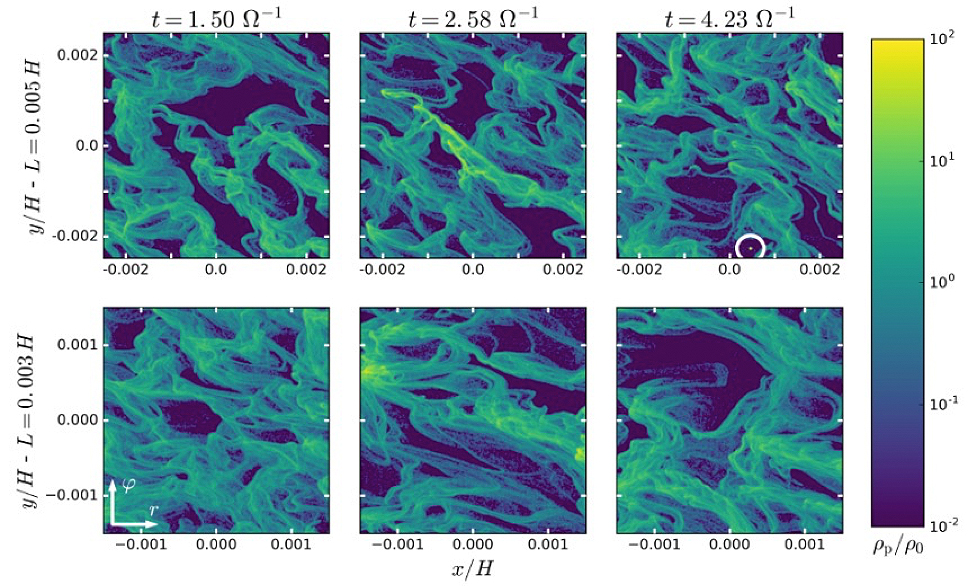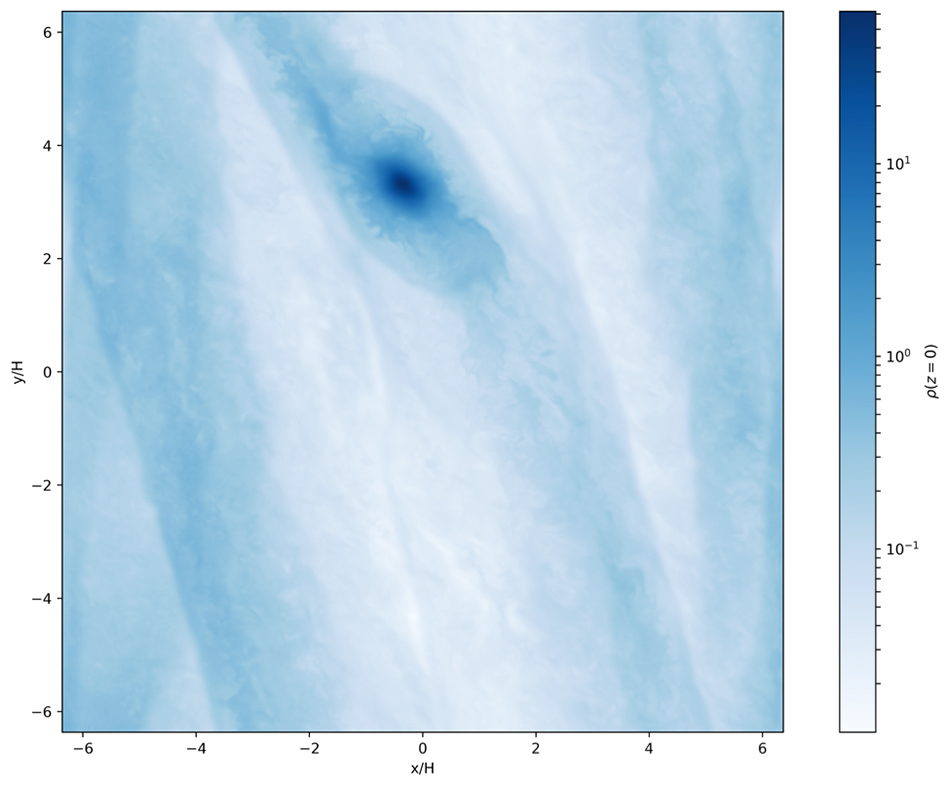ASTROPHYSICS
Planet Formation Through the Gravitational Collapse of Solids and Gas
Principal Investigator:
Hubert Klahr
Affiliation:
Max-Planck-Institut für Astronomie, Heidelberg (Germany)
Local Project ID:
hhd19
HPC Platform used:
JUQUEEN of JSC
Date published:
The Challenge
Planet formation is a beneficial side effect of star formation. When a large gas cloud collapses under its own weight creating a star, some of the material forms a disk out of dust and gas around this newborn star. Such disks can be found around stars younger than 10 million years, and we believe they are the origin of planetary systems like our own. They are composed mainly out of hydrogen and helium, plus 1-2% heavier elements which astronomers simply call metals. The initial metal abundance is 13 orders of magnitude lower than typical planet densities. Thus, the planet formation process must be very efficient in concentrating metals locally.
The first step towards planet formation require the coagulation of dusty ice grains. By sticking, these grains grow up to centimeters in size. Larger sizes are not possible since collisions then lead to destruction rather than to sticking. What follows is unfortunately not observable because meter-sized or even kilometer-sized objects are not detectable. Yet, having discovered thousands of planets around other stars the planet formation process must be very efficient in overcoming this and other growth barriers.
From our own solar system we know that planetesimals must have been formed, which are planetary building blocks of 100 kilometers in size. They subsequently then form cores of gas giants and terrestrial planets. Planetesimal leftovers can still be found today in the form of asteroids and comets. Thus, we would have a relatively clear evolutionary path from dust up to the final planetary system if we could explain how centimeter-sized pebbles can grow to planetesimals considering the effects of self-gravity and turbulence.
The turbulence has two effects on the dust, it mixes and diffuses the dust on large scales but also concentrates it on small scales [1]. Reaching a dust concentration of unity the streaming instability sets in, in which the gas starts feeling a significant back reaction from the dust. Moreover, in regions with densities larger than Roche density, at which tidal forces no longer prevent a gravitational collapse, the particle heap collapses into 100 – 1,000 km sized planet embryos.

Demonstration of the streaming instability in our simulations for different domain sizes and times, where yellow regions indicate high dust-to-gas ratios favorable for planetesimal formation.
Copyright: MPI for Astronomy, Heidelberg, GermanyAdditionally, we study the possibility that early self-gravitating disks fragment into gas giant planets through gravitational instabilities. We had previously studied the criterion for fragmentation [2] and now look at the potential for metallicity enrichment of these fragments during and after formation. While it is well known that the spiral arms induced by these gravitational instabilities collect solid material, potentially forming planetesimals, it is currently unknown how efficiently fragments themselves collect dust and particles of various sizes.
Our simulations use the Pencil Code [3] which contains a high order finite difference MHD code. Particles are treated as Lagrangian swarm particles. Our streaming instability runs use up to 5,123 grid-cells and 64 million particles [4], while the disk fragmentation simulations use more than 1 billion grid-cells [2]. They run for millions of computational steps before planetesimals start to form because the concentrations develop on viscous time scales, which are much longer than the dynamical time scales.
Results and Outlook
Over the last years we developed a planetesimal formation model based on the simulations we perform on the Jülich supercomputer JUQUEEN. These high-resolution hydro-dynamical simulations are completed in reasonable times due to the many thousands of cores available at JUQUEEN.

The formation of a gas giant planet through direct gravitational collapse, where darker blues indicate higher gas densities at the disk midplane.
Copyright: MPI for Astronomy, Heidelberg, GermanyCurrently we push our simulations to understand the efficiency of these processes and to derive initial mass functions for planetesimals and gas giant planets. The first goal will be achieved by better modelling the turbulence in disks and the second by performing high-resolution studies of the collapsing and possibly fragmenting particle clouds and gas clouds respectively. With both results in hand we can predict when and where planetesimals and Jupiter-like planets should form and of which size they will be. This is a fundamental step forward in understanding the formation of our own solar system as well as of the many planetary systems around other stars.
Acknowledgements
This project has received funding from the Deutsche Forschungsgemeinschaft within the Schwerpunktprogrammen (DFG SPP) 1385 "The first ten million years of the solar system" and 1833 “Building a habitable earth”. The authors gratefully acknowledge the Gauss Centre for Supercomputing (GCS) for providing computing time for a GCS Large Scale Project on the GCS share of the supercomputer JUQUEEN at Jülich Supercomputing Centre (JSC).
References
[1] Schreiber, A., Klahr, H. The Astrophysical Journal, 861, 47, 2018
[2] Baehr, H., Klahr, H., Kratter, K. M., The Astrophysical Journal, 484, 40, 2017
[3] http://pencil-code.nordita.org/
[4] Johansen, A., Klahr, H., Henning, Th. Astronomy and Astrophysics, 529, 62, 2011
Scientific Contacts
Hans Baehr, MA & Prof. Dr. H. Hubertus Klahr (PI)
Max-Planck-Institut für Astronomie
Königstuhl 17, D-69117 Heidelberg (Germany)
e-mail: klahr [@] mpia.de
http://www.mpia.de/homes/klahr
July 2018
JSC project ID: hhd19
